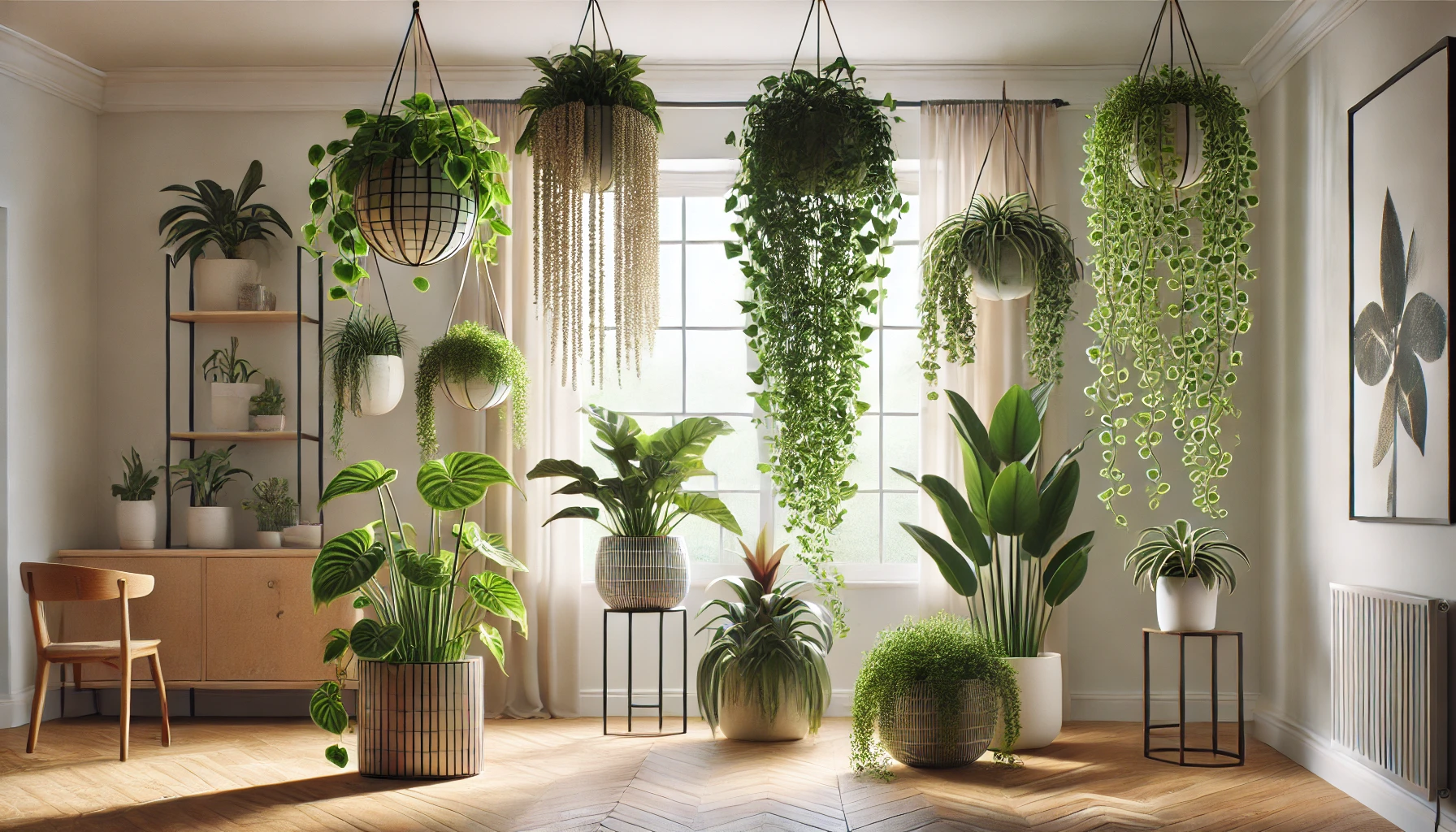Hanging plants are more than just a trendy decor choice — they’re a smart way to bring nature into your home without taking up valuable floor or shelf space. Suspended in the air, these plants add softness, movement, and charm to any room, especially when space is limited.
Whether you’re creating a lush green corner, brightening up a window, or adding a touch of life above your kitchen sink, this guide will help you choose the best hanging plants and teach you how to care for them the right way.
Why Choose Hanging Plants?
Hanging plants are perfect for:
- Small apartments and compact spaces
- Filling vertical areas with life
- Softening harsh lines in modern interiors
- Drawing the eye upward and creating balance in the room
They also add a sense of calm and elegance — gently swaying foliage brings energy and tranquility to your space.
Best Hanging Plants for Indoor Spaces
Here are some of the most beautiful, easy-to-grow plants that thrive in hanging pots or baskets:
Pothos (Epipremnum aureum)
One of the most popular and forgiving trailing plants. Grows quickly and adapts to different light levels.
- Light: Low to bright indirect
- Water: Let top soil dry before watering
- Bonus: Easy to propagate in water
String of Pearls (Senecio rowleyanus)
A unique succulent with bead-like leaves that cascade beautifully.
- Light: Bright, indirect (can tolerate some direct sun)
- Water: Infrequent, let soil dry out completely
- Tip: Use a well-draining cactus mix
Spider Plant (Chlorophytum comosum)
A classic hanging plant with long arching leaves and baby “spiderettes” that dangle from runners.
- Light: Bright, indirect light
- Water: Keep soil lightly moist, allow top inch to dry
- Bonus: Pet-friendly and great air purifier
Boston Fern (Nephrolepis exaltata)
Full, lush, and ideal for creating a jungle vibe.
- Light: Indirect light, high humidity
- Water: Keep soil consistently moist
- Tip: Mist often or use a humidifier nearby
String of Hearts (Ceropegia woodii)
Delicate heart-shaped leaves on long, thin vines — elegant and romantic.
- Light: Bright, indirect
- Water: Allow soil to dry out between waterings
- Bonus: Fast grower with proper care
English Ivy (Hedera helix)
A timeless trailing plant that grows long and lush in the right conditions.
- Light: Bright, indirect
- Water: Keep soil slightly moist, not soggy
- Tip: Prune regularly to control shape and encourage fullness
Dischidia (Dischidia nummularia)
Also called “String of Nickels”, this plant has thick, round leaves and an unusual look.
- Light: Medium to bright indirect
- Water: Let dry between waterings
- Ideal for a minimalist, modern space
Burro’s Tail (Sedum morganianum)
A succulent with soft, trailing stems full of plump, gray-green leaves.
- Light: Bright light, can handle some direct sun
- Water: Water deeply but infrequently
- Tip: Handle gently — leaves fall off easily
Care Tips for Hanging Plants
1. Choose the Right Pot
Always use pots with drainage holes. Lightweight plastic pots are great for hanging, especially when the plant will grow long and heavy.
You can also place a plastic nursery pot inside a decorative hanging basket — this makes watering and repotting easier.
2. Mind the Watering
Watering hanging plants can be tricky because they’re elevated and often out of easy reach.
Suggestions:
- Take the pot down when watering
- Use a watering can with a long, narrow spout
- Check the weight of the pot — light means it’s time to water
- Let water fully drain before rehanging
3. Light Matters
Hanging plants near windows or glass doors often get more consistent light, but you should still match the plant to the location.
Avoid placing light-loving succulents in shady corners, and don’t hang ferns in direct sunlight.
4. Rotate Regularly
Plants grow toward the light. To keep them even and full on all sides, rotate the pot a quarter turn every week or so.
5. Dust the Leaves
Leaves collect dust, especially in higher spots. Clean them gently every few weeks with a damp cloth or soft brush to help the plant photosynthesize efficiently.
6. Prune for Health and Shape
Trim long or leggy vines to encourage bushier growth. Remove yellow, dry, or damaged leaves to keep the plant looking vibrant.
Where to Hang Your Plants
Some perfect indoor spots for hanging greenery:
- In front of bright windows (avoid glass that gets too hot)
- Above kitchen sinks or bathtubs
- From curtain rods or ceiling hooks
- Along stairwells or hallways
- Over work-from-home desks for a calming touch
- As a natural room divider using a row of trailing plants
Use macramé hangers, minimalist wire hangers, or floating wall shelves to fit your style.
Final Thoughts: Let It Hang, Let It Grow
Hanging plants add dimension, movement, and life to your space — and they’re just as functional as they are beautiful. Whether you’re a beginner or an experienced plant lover, there’s a trailing or cascading plant that can elevate your home (literally).
Choose the right varieties, give them the care they need, and enjoy the peaceful beauty of greenery that floats in the air.
